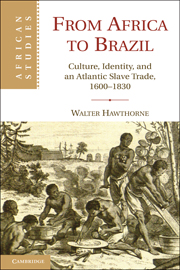Book contents
- Frontmatter
- Contents
- List of Figures
- List of Maps
- List of Tables
- Abbreviations Used in Notes
- Acknowledgments
- Introduction
- PART I THE WHY AND HOW OF ENSLAVEMENT AND TRANSPORTATION
- 1 From Indian to African Slaves
- 2 Slave Production
- 3 From Upper Guinea to Amazonia
- PART II CULTURAL CHANGE AND CONTINUITY
- Index
- References
2 - Slave Production
Published online by Cambridge University Press: 05 September 2012
- Frontmatter
- Contents
- List of Figures
- List of Maps
- List of Tables
- Abbreviations Used in Notes
- Acknowledgments
- Introduction
- PART I THE WHY AND HOW OF ENSLAVEMENT AND TRANSPORTATION
- 1 From Indian to African Slaves
- 2 Slave Production
- 3 From Upper Guinea to Amazonia
- PART II CULTURAL CHANGE AND CONTINUITY
- Index
- References
Summary
To supply slaves to its underdeveloped captaincies of Maranhão and Pará, Portugal renewed its interests after 1750 in the Upper Guinea ports of Cacheu and Bissau. Sailing times from these two ports to Amazonia were relatively short. Moreover, Portugal desperately wanted to reassert itself on a stretch of African coastline that it had long claimed. Having dominated trade from Upper Guinea since the mid-fifteenth century, Portuguese merchants found themselves unable to compete with rivals from France and Britain toward the end of the seventeenth. Portuguese administrators and merchants constantly complained that “interlopers” were overrunning “our Guinea.” When European conflicts, particularly the Seven Years’ War (1756–1763), distracted France and Britain, Portugal saw an opening to reclaim “their” ports.
Just after the mid-eighteenth century, Portugal decided that the cheapest way to control trade from Bissau and Cacheu was to grant a trade monopoly to a private entity – the Company of Grão Pará and Maranhão (CGPM). It would defend Portuguese interests by building forts and pacifying independent-minded coastal peoples and would supply slaves to Amazonia. The monopoly went into effect in 1755 and ended in 1778 with the company continuing to trade in a freer market through 1787. Although interlopers continued to take a portion of the trade that Portuguese merchants considered theirs, the Portuguese trade in slaves from Bissau and Cacheu increased dramatically after 1755, the volume remaining at relatively consistent levels through abolition in 1815. Slave exports between 1751 and 1800 were 88 percent higher than from 1701 to 1750. By the 1780s, settler-controlled regions of Maranhão, which only decades earlier had had few blacks, boasted a black majority. Of those blacks, most hailed from Upper Guinea. Although exports from Bissau and Cacheu were never enough to satisfy the insatiable desire of shippers and planters for an ever-increasing flow of slaves, the CGPM succeeded in ensuring a Portuguese presence on the Upper Guinea coast and in substantially increasing Portuguese trade there.
- Type
- Chapter
- Information
- From Africa to BrazilCulture, Identity, and an Atlantic Slave Trade, 1600–1830, pp. 61 - 96Publisher: Cambridge University PressPrint publication year: 2010

